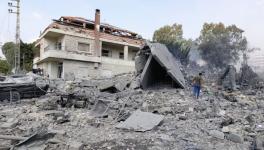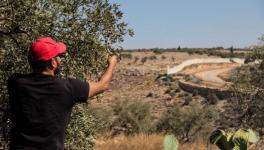How Lebanese Resistance Struck Heavy Blow Against Israel

Displaced returning to Beirut's southern suburbs. (Photo:Haitham Al-Moussawi).
After around 14 months of Israeli aggression, and two months of intense escalation, the Lebanese resistance group Hezbollah forced Israel to sign a ceasefire agreement and end its heavy aerial bombing campaign against Lebanon. The agreement, seen as a strong victory by the resistance group, was achieved despite the huge humanitarian and military losses inflicted on the Lebanese people and their resistance.
The Zionist onslaught claimed over 3,823 lives, and left at least 15,859 injured, according to the Lebanese Health Ministry. According to the United Nations High Commissioner for Refugees (UNHCR), around 1.2 million people were displaced during the war, in a country that has suffered a debilitating economic crisis since 2019.
The aggression caused considerable material damage in different sectors as well, further aggravating Lebanon’s economic plight. According to a report published by the World Bank on November 14, the cost of physical damages and economic losses that resulted from the war in Lebanon is estimated at 8.5 billion US dollars. This includes 3.4 billion dollars damage to physical structures, and 5.1 billion dollars in economic losses.
The most affected sector among all was the housing sector with around 100,000 housing units partially or fully damaged. Whereas, agricultural losses and damages are estimated at almost 1.2 billion dollars due to destruction of crops and livestock, alongside the displacement of farmers. In addition, the report estimated that 166,000 individuals have lost their jobs because of the war.
How Hezbollah persisted despite huge losses?
There are multiple reasons to believe that Hezbollah triumphed in its prolonged battle against Israel. Hezbollah is a group that operates within a limited geographical area, while surrounded by multiple national and regional geopolitical challenges. Whereas, Israel has been backed by the United States and the North Atlantic Treaty Organization (NATO), which has over 40,000 troops stationed in military bases across West Asia.
Nevertheless, Hezbollah showcased its steadfastness and blocked Israel from achieving any of its objectives. In a televised speech released on Friday, November 29, Hezbollah Secretary General Sheikh Naim Qassem described the triumph of Hezbollah in the war as a victory that is greater than that reached in 2006 despite all the sacrifices made by the group, and the Western support provided to Israel. “َWe are witnessing a great victory because we prevented the enemy from destroying Hezbollah, weakening the Resistance, and forced the enemy to justify itself to its public,” the top Hezbollah leader said.
Resistance re-unified Lebanese people against the enemy
Political sectarianism within Lebanon has been a major challenge on the national level. However, the latest Israeli aggression showed that the Lebanese people became more aware of the importance of national unity. In a televised speech, Lebanese House Speaker Nabih Berri said on Tuesday, November 27: “The war showed the true face of Lebanon in terms of national unity.”
In addition, Hezbollah has apparently garnered greater support and popularity by the Lebanese people in the aftermath of the Israeli aggression. In this regard, American-Lebanese journalist Rania Khalek said during a special live episode of Dispatches with Lebanese journalist Ghadi Francis: “I think that when it comes to Hezbollah, their enemies often forget that this is not just some group that exists completely detached from Lebanon, I mean we saw the same images today of Lebanese people who have been displaced going back to their villages and their towns, the first chance they got, whose flags were they waving? They were waving the Lebanese flags and they were waving Hezbollah’s flags.”
The role of unity among Lebanese sects and factions in foiling Israel’s attempts to incite a strife was stressed by Sheikh Naim Qassem, who said that “the occupation bet on internal discord with the hosts, but this gamble failed due to cooperation among sects and factions. The legendary and sacrificial [Martyrdom-Seeking] steadfastness of the fighters astonished the world, terrified the Israeli army, and sowed despair among the enemy.”
Hezbollah’s popularity across the region bounced back
On the regional level, Hezbollah has been surrounded by many countries that are both submissive to the US and its allies, and which consider Hezbollah a rival due to its anti-Zionist and anti-imperialist ideology that conflicts with their own political interests. For decades, the government of these countries worked hard to incite their people against Hezbollah, by systematically fueling a Shiite- Sunni sectarian and doctrinal strife through malicious propaganda.
Nonetheless, after Hezbollah became the major support front to Gaza, and sacrificed its leaders to defend the Palestinian people, which saw its popularity bounce back among the peoples of the region. Meanwhile the position of Arab and Islamic countries continues to be characterized by their inaction in the face of genocide and declining popularity.
Hezbollah’s steadfastness and resilience
Hezbollah proved to be unshaken by the assassinations of its top leaders and by the massive terrorist pager and walkie-talkie attacks that it endured. The organization was able to recover in a record time and intensified its attacks against the invading Israeli forces, reaching positions deep in Israel through drone and missile strikes.
Hezbollah’s capabilities are deemed limited in terms of personnel, resources and weaponry when compared to Israel, which possesses huge and advanced weapon stock. However, the Lebanese resistance group was able to fight back relentlessly. Commenting on this specific point, Lebanese journalist Ghadi Francis said during the aforementioned episode of Dispatches: “You are talking about F-35s fighting people after the infiltration with the AI systems, and that couldn’t stop 560 sirens in three hours from blowing off and on in Tel Aviv, eight weeks after the trials to invade Lebanon, and one year after bombing and striking targets of all shapes and types in Lebanon.”
Moreover, from a military perspective, Hezbollah is said to have triumphed as it prevented IOF’s land incursions into southern Lebanon. In the instances when IOF soldiers were able to invade some villages and towns in the area, they were quickly pushed out by resistance fighters and unable to hold territory.
The Lebanese resistance group also managed to inflict considerable damage to key positions in Israel through more than 4,637 announced military operations over 417 days, with an average of 11 operations daily. According to a statement published by Hezbollah’s operation room on Wednesday, November 27, the group killed over 130 Israeli soldiers and officers, with more than 1,250 wounded during these operations. Meanwhile, 59 Merkava tanks, 11 military bulldozers, two Hummers, two armored vehicles, and two personnel carriers were destroyed. Furthermore, six Hermes 450 drones, two Hermes 900 drones, and one quadcopter glider were downed.
Israel’s losses were implicitly articulated by Israeli Prime Minister Benjamin Netanyahu in a press conference on Tuesday, November 26, when he claimed that reactivating the army, and overcoming the restrictions imposed on the arms supplies to ‘Israel’, were among the reasons that pushed Israel to approve the ceasefire deal.
Israel’s military failure in Lebanon is said to have driven the US administration to push Netanyahu towards the negotiations table for a ceasefire in Lebanon according to Member of Hezbollah Central Council Sheikh Hasan al-Baghdadi.
“What happened was due to the huge difference in capabilities between Hezbollah and the resistance in Palestine, which put the temporary entity in the circle of danger. Therefore, the Americans and others began to pressure Netanyahu’s government to stop the war out of fear for them and their certainty that the Israeli army is unable to win, not for the sake of Lebanon, as all the killing and destruction here were by American missiles,” Al-Baghdadi stated.
US and Israel’s plans for “New Middle East” fall apart again
The intended plans of the United States and Israel to re-shape the West Asia region have once again collapsed. Hezbollah has succeeded in preventing Israel and the US from tampering with the security, sovereignty, and unity of Lebanon. The Lebanese group also reaffirmed that resistance against the Zionist entity is a demand by people across the region, which in turn undermines Israel’s grueling efforts for expansion, normalization, and the liquidation of the Palestinian cause.
This was reaffirmed by Sheikh Naim Qassem in his Friday’s speech as he stated that Israel made its plans 64 days ago to eradicate Hezbollah, let Israeli settlers return to their residences in the north, and establish a “New Middle East”. However, Hezbollah managed to remain steadfast on the frontlines and launched airstrikes on the Israeli internal front, placing the Zionist entity in a significant defensive position. In addition, the number of displaced settlers in Israel has increased from 70,000 to hundreds of thousands.
Get the latest reports & analysis with people's perspective on Protests, movements & deep analytical videos, discussions of the current affairs in your Telegram app. Subscribe to NewsClick's Telegram channel & get Real-Time updates on stories, as they get published on our website.
























